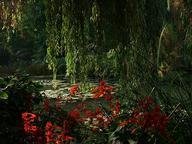Quiz Answer Key and Fun Facts
1. Born in 1839 in Aix-en-Provence in the South of France. Personal friend of Emile Zola, whom he later joined in Paris. Painted with Pissarro at Auvers near Paris, but soon moved away from Impressionism by his so-called 'constructive approach'. Typical subjects: still-lifes; cardplayers; isolated houses; the mountain peak of Mont St. Victoire. Who was he?
2. Born in Le Havre, Normandy in 1877; he died in 1953. Regattas, casinos, palmtrees, racecourses and orchestras are the typical 'ingredients' of his works. He excels by his linear virtuosity and brilliant colour. 'La vie en rose' was not just the name of one of his paintings, but might have been a good motto for the charming lightness of all his works. Nicknamed 'the granddaddy of modern chic' by Time Magazine in 1950-51.
3. Born in Paris in 1848 as the son of a French journalist and a Peruvian Creole.He was brought up in Lima, joined the merchant navy in 1865, and had begun a successful career as a stockbroker in Paris already, when he suddenly came into touch with the Impressionists. Spent 17,000 ancient French francs on buying some of their works. Befriended by Pissarro and later by Cezanne. Also van Gogh. After Rouen, Paris, Denmark, again Paris, Pont-Aven in Brittanny, he finally chose French Polynesia as his homebase. He died on one of the Marquesas islands in 1903. 'Where Do We Come From? What Are We? Where Are We going?' is the title he gave to one of his best-known works.
4. Born in 1881 ,died in 1955, this French 'Cubist' was often mockingly called a 'Tubist', as a tangle of coloured tubes is what his works most of the time look like. Seems to celebrate the rise of modern technology, and he kind of gets the roar of the factory and the screech of unoiled gear into his paintings. Surprisingly 'heavy' stuff.
5. Born in Paris 1839, died near Paris in 1899. English roots. Started a painting career in Paris at age 23, after getting fed up with his business career. First exhibition in 1867 showed a strong influence of Corot. Soft harmonious colours. Typical are his gentle, idyllic paintings of scenes near Paris: Marly, Bougival, Louveciennes, Moret-sur-Loing where he died.With his friends Monet, Renoir, Pissarro one of the creators of Impressionism.
6. This artist was a 'she'. Born in 1841, became the sister-in-law of Edouard Manet. Not only was she a good painter, but also an excellent organiser and 'driving force' behind the Impressionist movement. Her name?
7. Born in Paris in 1876; died at Reuil-la-Gadeliere in 1958. Truly one of the 'wild beasts' or 'fauves' in French painting. Apart from being a painter, he also was a violinist and a...racing cyclist. To demonstrate his hatred of 'tradition', he stubbornly refused ever to enter the Musee du Louvre.Was an admirer and imitator of van Gogh's energetic brushstrokes. Landscapes rather than portraits were his main subject. Though truly French by ID, neither his name nor his style were felt to be very 'French'.
8. Born in 1844, this French artist never got any official 'artistic training'. He had a lifelong job in the Parisian customs office. The 'jungle-paintings' he is famous for were not inspired by any real-life acquaintance with jungle-animals, but based on print-books and on the exotic spectacles he saw at the Parisian 'Jardin des Plantes' (Botanic Garden). Typical works: The Sleeping Gypsy; Scout Attacked by a Tiger; Fight Between a Tiger and a Buffalo. The Surrealists adopted him as their 'founding father' because of the dreamlike force of many of his works. Died in 1910.
9. Born in 1869 in the North of France (Le Cateau en Cambresis). Views through an open window, dancers, music, rich colourful dress and richly furnished interiors are his hallmark.Somehow he prefers to stay away from all references to the conflicts and troubles of human existence,and focused on what the title of one of his best-known early paintings describes as 'Luxe, Calme et Volupte.' Luxury, calm and pleasure. Died at Nice in 1954, his main other residences having been Collioure (a coastal village); Paris; Nice; Vence near Cannes.
10. Born in Paris in 1871. Died in Paris in 1958. Originally he belonged to the group of the 'Fauves', but soon the themes and the style of his work gave him a position very much of his own.The heavy dark contours of his figures seems to have been influenced by his early career as a stained glassmaker. As to the subjects of his work, they often refer to the life, passion and death of Christ. Sin is constantly present, and seen as inherent to the human condition. We think ourselves Kings, but are in true fact circus clowns disguising our true natures via masks. From a painter he developed into a graphic artist. Typical works of his: Miserere 1923; Circus of the Shooting Star 1938.
Source: Author
flem-ish
This quiz was reviewed by FunTrivia editor
Terry before going online.
Any errors found in FunTrivia content are routinely corrected through our feedback system.

